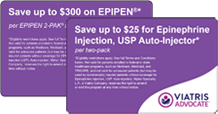Important Safety Information (the following information applies to both Epipen and its Authorized Generic)
EPIPEN (epinephrine injection, USP) 0.3 mg and EPIPEN JR (epinephrine injection, USP) 0.15 mg Auto-Injectors are intended for immediate administration as emergency supportive therapy only and are not intended as a substitute for immediate medical or hospital care. In conjunction with the administration of epinephrine, the patient should seek immediate medical or hospital care. More than two sequential doses of epinephrine should only be administered under direct medical supervision.
EPIPEN and EPIPEN JR should only be injected into the anterolateral aspect of the thigh. Do not inject intravenously, into buttock, or into digits, hands, or feet. Instruct caregivers to hold the leg of young children firmly in place and limit movement prior to and during injection to minimize risk of injection-related injury.
Rare cases of serious skin and soft tissue infections have been reported following epinephrine injection. Advise patients to seek medical care if they develop symptoms of infection such as persistent redness, warmth, swelling, or tenderness at the injection site.
Epinephrine should be used with caution in patients with heart disease, and in patients who are on drugs that may sensitize the heart to arrhythmias, because it may precipitate or aggravate angina pectoris and produce ventricular arrhythmias. Arrhythmias, including fatal ventricular fibrillation, have been reported, particularly in patients with underlying cardiac disease or taking cardiac glycosides, diuretics, or anti-arrhythmics.
Patients with certain medical conditions or who take certain medications for allergies, depression, thyroid disorders, diabetes, and hypertension, may be at greater risk for adverse reactions. Common adverse reactions to epinephrine include anxiety, apprehensiveness, restlessness, tremor, weakness, dizziness, sweating, palpitations, pallor, nausea and vomiting, headache, and/or respiratory difficulties.
Indications (the following information applies to both EPIPEN and its Authorized Generic)
EPIPEN and EPIPEN JR Auto-Injectors are indicated in the emergency treatment of allergic reactions (Type I) including anaphylaxis to stinging insects (e.g., order Hymenoptera, which include bees, wasps, hornets, yellow jackets and fire ants) and biting insects (e.g., triatoma, mosquitoes), allergen immunotherapy, foods, drugs, diagnostic testing substances (e.g., radiocontrast media) and other allergens, as well as idiopathic anaphylaxis or exercise-induced anaphylaxis. EPIPEN and EPIPEN JR Auto-Injectors are intended for immediate administration in patients who are determined to be at increased risk for anaphylaxis, including individuals with a history of anaphylactic reactions.
Click here for Full Prescribing Information for EPIPEN.
Click here for Full Prescribing Information for the Authorized Generic for EPIPEN.

EPI-2018-0365
EPIPEN®, EPIPEN JR®, EPIPEN 2-PAK®, EPIPEN JR 2-PAK®, EPIPEN4SCHOOLS®, NEVER-SEE-NEEDLE® and the EPIPEN® Logo are registered trademarks of Mylan Inc., a Viatris Company. VIATRIS and the Viatris Logo are trademarks of Mylan Inc., a Viatris Company. All other trademarks and service marks are the property of their respective owners. This website is intended for residents of the United States who will prescribe or fill prescriptions for patients located within the United States.
© 2023 Viatris Inc. All Rights Reserved. EPI-2021-0172 V6







